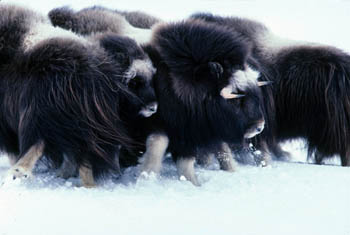![[Metroactive Movies]](/movies/gifs/movies468.gif)
[ Movies Index | Show Times | Silicon Valley | Metroactive Home | Archives ]

Baby, It's Cold Outside: Musk ox struggle to survive in the Arctic wilderness. Arctic Chill 'Oil on Ice' looks at drilling threat to Alaska By Marianne Messina PRODUCERS Dale Djerassi and Bo Boudart's Oil on Ice, a documentary about the issues surrounding oil drilling in the Alaska National Wildlife Refuge, starts out with a good bit of preaching to the choir—close-ups of fuzzy waddling bears, big-eyed caribou calves and lonely birds peeping in the snow. Supported in part by the Sierra Club, Oil on Ice is an apt vehicle for mobilizing that base with its aerial views of pristine tundra and snow-capped mountains, migrating caribou and geese taking flight. Unlike similar documentaries that send people out grumbling and never tap the sentiments stirred by the film, the Oil on Ice project comes with an Action Tool Kit (www.oilonice.org). It contains instructions for would-be activists, such as how to have a "successful lobby visit," write a letter to a representative or find out the name of your congressperson. It's enough to make you feel like you can do something. But in terms of convincing a public driven by panic and pressured by oil concerns to see only myopic solutions, the first part of the documentary has trouble getting out of its own way. The opening speakers, for example, include artist Char Davies saying, "This huge landscape is here just for the animals." Oops. The film introduces Gwich'in Indian activist Adeline Peter Raboff. She talks about a way of life centered around the migrating caribou, a migration sure to be rerouted by the proposed drilling. We learn that the Gwich'in community's population numbers about 8,000. We meet Indian activists like Charlie Swaney out in front of his ramshackle cabin saying, "There's no jobs here and there's very little money. ... We live off the land." And we learn of a town project based on oil monies, which will install gas and flushing toilets in every home. It almost seems to make a case in favor of opening up the 1.5 million ANWR acres to oil development. Even Robert Thompson, a hunter and guide who traveled to Washington, D.C., to protest the oil drilling proposal, admitted that "there's been an improved standard of living" in the area since the oil industry went in. The film's Michael Moore moment shows Thompson standing with Alaska Republican Sen. Ted Stevens outside a government building in Washington. "You're here to help us on ANWR?" the senator asks. "Actually," says Thompson, "I'm opposed to development." "You're going to give back your permanent fund?" the senator asks as he scurries away from the camera (which follows him out of sight). Stevens is referring to money every resident of Alaska receives annually as a dividend from oil company profits. Amory Lovins of the Rocky Mountain Institute calls it "a reverse income tax" and likens it to an addiction. Djerassi begins to make a more convincing argument when he takes his documentary to the 1989 Exxon Valdez spill. There, marine toxicologist Riki Ott explains how "the fish crashes in 1992 and 1993" led to the discovery that long-term toxins from the spill are damaging salmon and herring populations on a genetic level. "You're not seeing carcasses," says Ott, "you're seeing decreased productivity over time." After a few more revelations about the false promises of the oil solution, the film turns to fuel efficiency followed by an upbeat look at reusable energy sources as a replacement for oil. In this way, the film stresses what people can do, rather than getting mired in rants over what's wrong. Oil on Ice is showing in conjunction with the Sierra Club and other progressive groups. And it's uniquely positive in positioning people to act.
Oil on Ice shows March 9 at 7pm at Quinlan Community Center, 10185 N. Stelling Rd., Cupertino. There will be a discussion with the filmmaker. Free.
Send a letter to the editor about this story to letters@metronews.com. [ Silicon Valley | Metroactive Home | Archives ]
|
From the March 2-8, 2005 issue of Metro, Silicon Valley's Weekly Newspaper.
Copyright © Metro Publishing Inc. Metroactive is affiliated with the Boulevards Network.
For more information about the San Jose/Silicon Valley area, visit sanjose.com.